New South
Wales The earliest is this
New South
Wales Stamp, 4d of the 1888 centennial of settlement issue. Its origin is
discussed here.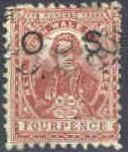
|
Other early and first country issue Cook stamps include:
|
| New Zealand
1906, - Christchurch Exhibition:
|
Landing of Cook.
3d, (1st. Voyage, Poverty
Bay, October 8th, 1769). It is not based on any contemporary picture.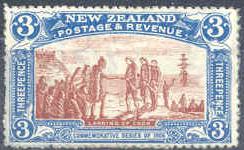
The designer of this series of stamps
was L.J. Steele - a genre painter - best remembered today for his joint
effort with Goldie - the Arrival of the Maoris in New Zealand - (See
- Figure 3).
This series
was hugely controversial at the time because it was New Zealand's first
commemorative series. The one earlier commemorative stamp - about the
Boer War - was hidden within the first pictorial set. Philatelists
then saw commemorative stamps as the road to ruin - and they had a point
didn't they? The designs were also panned and one can see why. Still
they have a high catalogue value today. Catalogue
|
Annexation of New Zealand.
* 6d, (1st. Voyage, Mercury Bay, 15 November 1769). It is not based on
any contemporary picture.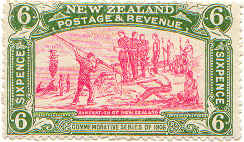
Whitianga in Mercury Bay has a Cook
Museum.
* An
authoritative source says that the stamp depicts Cook's
"annexation". Cook's
instructions were only to take possession with the consent of the native
people. He certainly did not have that. His act of annexation in Mercury Bay was not given effect to and today
is treated as a footnote to the colonisation of New Zealand. The effective
annexation was that of Hobson on May 21st 1840, in Auckland, after the earlier
signing of the
Treaty of Waitangi and its hawking around as many Maori chiefs as would sign, by
Major Bunbury. Another source says that is what is depicted. From the content
showing a shore party I think the former is correct.
|
Rarotonga (Cook
Islands) and other islands in the group.
1920 Cook
definitive.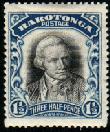
|
USA 1928, 150th
anniversary of Cook's Discovery of Hawaii.
Overprints, without reference to Cook but that is what they were about.
|
|
On 2c Washington, 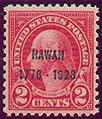 |
|
On
5c Roosevelt. 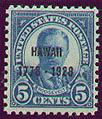
|
Rarotonga (Cook
Islands) (and others)
1932 Cook
definitive. 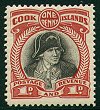
Not identified as Cook on the stamp but clearly is derived from Dance, but
with the hat added and different uniform. Paul den Ouden kindly
advised on the origin " This was
drawn from a photograph of a steel engraving of the famous painting by
N. A. Dance, R.A., Mitchell adding the admiral's hat. Another steel
engraving from the same portrait was used for the 1½d. value of the
1920 set. The two engravings, although of the same painting, varied in
the expression on Cook's face and other details. The Mitchell referred to is L.C. Mitchell, of
Wellington, NZ who was the designer of the complete 1932 set. I've
attached a scan of one of the essays, sans hat. " 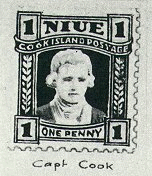
|
New Zealand
1935, Landing of Cook 2/- (This one an Official stamp - used by
Government departments.)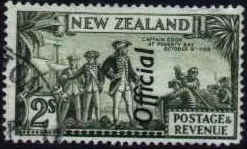
|
New Zealand
1940. 1d New Zealand Centennial. The first stamp to identify Endeavour.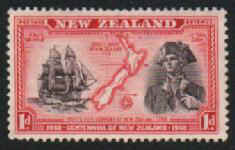 |
|
New Zealand
1959. 2d
Marlborough Centennial. Careening of Endeavour
at Ship Cove 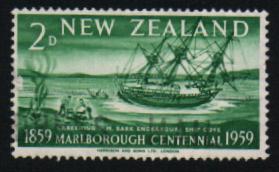 The
first stamp just about Endeavour. It
is not based on any contemporary picture.
Ship Cove is in the Marlborough Sounds at the north end of the
South Island. Other stamps above have a ship in the background,
which from context is Endeavour but it is not identified on the
stamp as such. The first
identifying Endeavour is the 1940 New Zealand issue.
|
Niue
1950
The first stamp to identify Resolution. 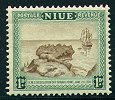
|
Australia
1964, Navigators 7/6 This short
lived issue was replaced in 1966 by a decimal stamp of 75c
denomination, using the same design.
|
Remarkably this design had yet a third
outing in a stamp exhibition miniature sheet of 1999, this time at
45c denomination, flanked by Tasman and Flinders from the same 1964 set. 
|
Great
Britain 1968, Bicentenary 1/9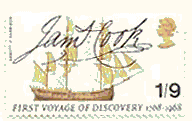
|